Alibaba: Better Days Ahead
Summary
- Alibaba reported mixed second quarter results.
- But the cloud market, the e-commerce business and international expansion offer growth opportunities.
- And the stock remains deeply undervalued.
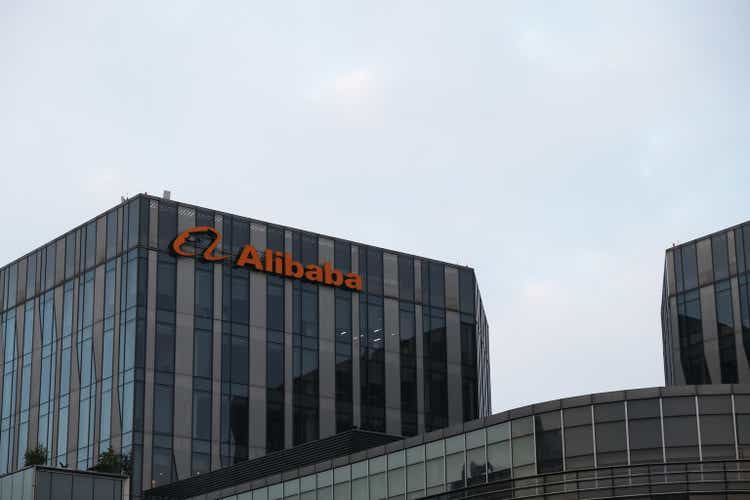
Robert Way/iStock Editorial via Getty Images
My last article about Alibaba Group Holding Limited (NYSE:BABA) was published about three months ago in May 2024. Since my last article was published, the stock declined about 5%, while the S&P 500 (SPY) increased about 5% in the same timeframe.
Last week, Alibaba reported second quarter results and while the company did beat estimates for non-GAAP EPS, it missed revenue by about $1.15 billion. And the stock continued to be caught in its huge range between about $60 on the downside and about $90 on the upside. But let’s look at the company and stock once again and explain why I still remain long-term bullish. We start – once again – by looking at the last quarterly results.
Quarterly Results
Revenue increased from RMB 234.2 billion in Q2/23 to RMB 243.2 billion in Q2/24 resulting in 3.8% year-over-year growth. And while top line increased in the low single digits, income from operations declined 15.3% year-over-year from RMB 42,900 million in the same quarter last year to RMB 35,989 million this quarter. Finally, diluted earnings per share also declined 25.3% year-over-year from RMB 1.66 in Q2/23 to RMB 1.24 in Q2/24.
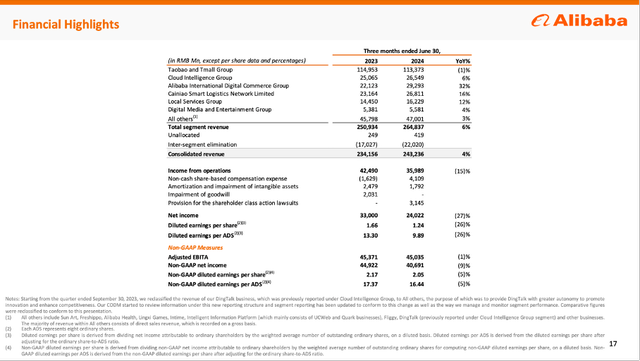
Alibaba Q2/24 Presentation
One of the most important metrics we should pay attention to is the free cash flow. And Alibaba reported only a free cash flow of RMB 17,372 million in Q2/24 and compared to a free cash flow of RMB 39,089 million in Q2/23 this was a 55.6% year-over-year decline.
And while I was rather optimistic in previous articles that Alibaba might turn around and the situation in China might improve, it seems like the picture is rather getting worse again. To get a feeling for the bigger picture it is simply not enough to just look at results from three months, but we have to look at least at a few years.
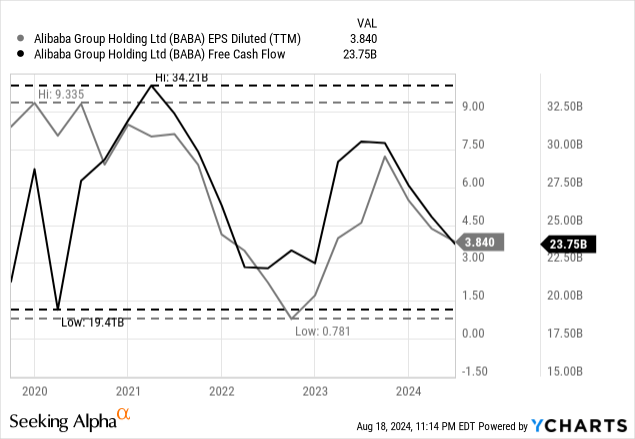 Data by YCharts
Data by YCharts
Until 2022 we saw stable revenue growth (and high-growth rates) but since then, revenue is rather stagnating or growing in the low single digits at best. And while revenue is at least stable, earnings per share, as well as free cash flow, are fluctuating wildly in the last few quarters, and it seems rather like a roller-coaster ride than a growing or improving business. Especially in the last few quarters, trailing twelve months earnings per share and free cash flow declined again.
E-Commerce: Taobao and Tmall Group
Aside from just looking at the income statement, we can also look at the different segments and following a restructuring of the business a few quarters ago, Alibaba is now reporting in six different segments. Alibaba can be described as a diversified company, but its bread-and-butter business is e-commerce and retail.
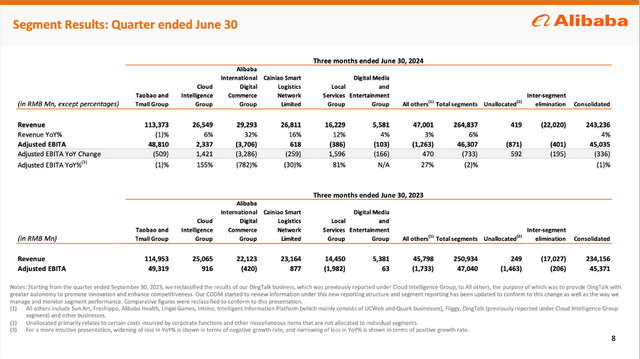
Alibaba Q2/24 Presentation
The Taobao and Tmall Group is still the most important segment for Alibaba, as it is generating the biggest part of revenue and – even more important – almost the entire operating income. In Q2/24, the segment generated RMB 113,373 million in revenue (a 1% decline compared to the same quarter last year) and an adjusted EBITDA of RMB 48,810 million (also a 1% decline compared to Q2/23). And although Alibaba tried to frame the results of the segment positive, the segment clearly struggled.
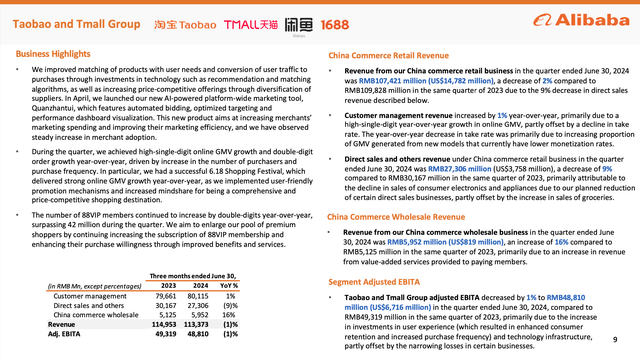
Alibaba Q2/24 Presentation
JD.com (JD), which reported quarterly results on the same day as Alibaba, presented similar results for its JD Retail Segment. However, the results JD reported were slightly better than Alibaba’s results, as JD still reported a slightly increasing revenue and an increased operating income.
And overall, it is not surprising that the retail business in China is struggling. When looking at GDP growth in China in the last few quarters, the country is still reporting growth but in the second quarter of 2024, GDP grew only 0.7% YoY – for China these are very disappointing growth metrics. Not only GDP growth is struggling, but retail sales are also growing with a very low pace and growth rates are continuing to get lower in the last few months. In July 2024, retail sales still increased 2.7% year-over-year.
The segment is struggling, but Alibaba has now 44 million 88VIP members and compared to about 25 million members two years earlier, the number almost doubled. Amazon Prime has about 200 million to 230 million members (numbers are fluctuating according to different sources) but while 88VIP was launched in 2018, Amazon launched Prime already in 2005. And over time, 88VIP might contribute to Alibaba’s growth the same way Prime contributed to Amazon in the last two decades.
Cloud Intelligence Group
One of the segments on which hopes for future growth rely on is the Cloud Intelligence Group and in Q2/24, the segment generated RMB 26,549 million in revenue – an increase of 5.9% compared to the same quarter last year.
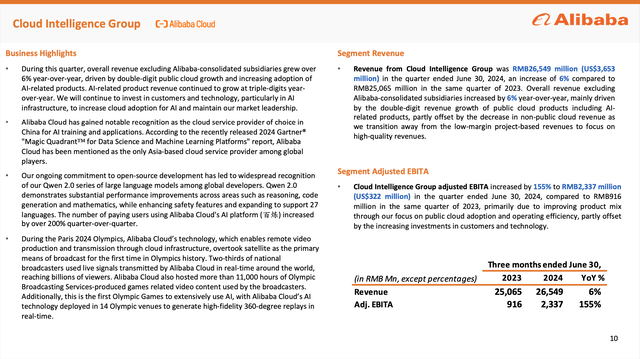
Alibaba Q2/24 Presentation
And the segment is also making progress on its way to solid margins and profitability as adjusted EBITDA improved from RMB 916 million in the same quarter last year to RBM 2,337 million this quarter. Management commented during the last earnings call:
During this quarter, overall revenue excluding Alibaba-consolidated subsidiaries grew over 6% year-over- year, driven by double-digit public cloud growth and increasing adoption of AI-related products. AI-related product revenue continued to grow at triple-digits year-over-year. We will continue to invest in customers and technology, particularly in AI infrastructure, to increase cloud adoption for AI and maintain our market leadership.
Alibaba was also one of the major sponsors not only of the European Championship in Germany in June 2024, but also of the Olympic Summer Games in Paris in August 2024:
This year, Alibaba Cloud served as a major cloud service provider for the Olympic Games, providing cloud computing and AI services to Olympic broadcasting services, OBS. At the Paris Olympics, cloud-based live broadcast powered by Alibaba Cloud over satellite signals as the primary means of broadcast for the first time in Olympic history. Two-thirds of broadcasters used live signals transmitted by Alibaba Cloud and real-time around the world, reaching billions of viewers.
International Expansion
And presenting itself to the world is helping Alibaba to get more known outside of China. Let’s face it, outside of the investment world, most people are unfamiliar with Alibaba – especially in Europe and the United States. When comparing the worldwide search volume for Amazon and Alibaba, we see the search volume for Alibaba is almost not measurable.
However, there are countries where the search volume for Alibaba is higher than for Amazon. These countries are including some Asian countries (not surprisingly, China as well) and we are seeing especially high search volume (compared to Amazon) in several African countries. The following map is showing the countries with a rather high search volume for Alibaba.
The highest search volume for Alibaba in some African countries is also going hand-in-hand with China’s soft power approach, which is especially effective in Africa and leading to close trade relationships between China and African countries.
Alibaba International Digital Commerce Group
Another segment reporting high-growth rates is the Alibaba International Digital Commerce Group, which grew its revenue 32.4% year-over-year from RBM 22,123 million in the same quarter last year to RMB 29,293 million this quarter. However, while revenue grew with a high pace, the segment is still not profitable and while the adjusted EBITDA was a loss of “only” RMB 420 million in the same quarter last year, it was a loss of RMB 3,706 million this quarter.
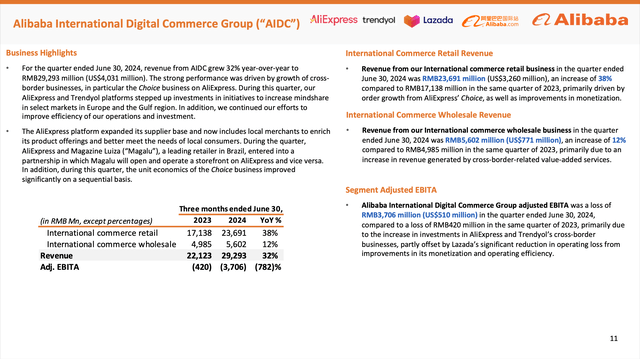
Alibaba Q2/24 Presentation
During the last earnings call, management talked quite a lot about the AIDC segment (Alibaba International Digital Commerce Group) and Jiang Fan, the CEO of the AIDC Group was on the earnings call once again (he was also participating in the last few earnings calls).
Fan talked about the strategy and business drivers the segment is currently focusing on. Aside from supply chain upgrade and constantly optimizing logistics and lowering the average delivery time, Alibaba is especially focusing on product on technology innovation:
We advanced our AI and intelligent technologies across scenarios like AI customer service, cross-platform product placement, product description optimization, multilingual search and price recommendations, which boosted efficiency and user experience. These innovations were deployed across our platforms and have served around 500,000 merchants and covered 100 million SKUs.
And of course, Alibaba is focusing on key markets (including Turkey and Southeast Asia) to achieve sustained growth in these key markets.
Share Buybacks
In the last few years, share buybacks have become an important part of Alibaba’s capital allocation strategy and the company is continuing to repurchase shares with a high pace and considering the extremely low stock price (we will get to this), management should use as much free cash flow as possible for share buybacks right now.
 Data by YCharts
Data by YCharts
I made a similar argument about PayPal (PYPL) in my last article. As long as the share price is remaining at a depressed level, management should focus on share buybacks. But compared to PayPal, Alibaba is already paying a dividend and must use a part of free cash flow for these payments. If Alibaba would use the entire free cash flow of the last four quarters, which was $25.54 billion (we are using the USD numbers as the stock we are looking at – BABA – is also trading in USD) for share buybacks (and assume the share price will remain at a similar level), the company can repurchase about 13% of all outstanding shares in a single year.
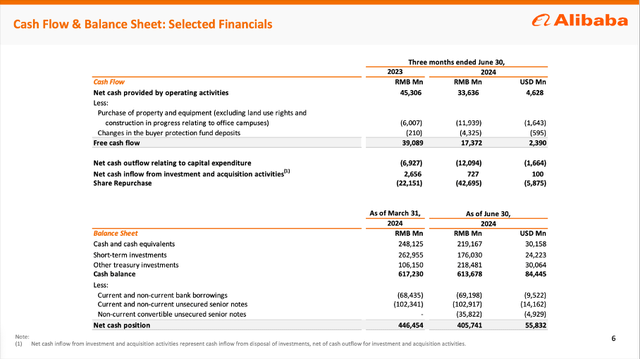
Alibaba Q2/24 Presentation
Additionally, Alibaba has $30,158 million in cash and cash equivalents on the balance sheet and short-term investments of $24,223 million (on June 30, 2024). In theory, Alibaba could use the cash, cash equivalents and short-term investments for share buybacks. This is enough to repurchase 27.5% of total shares outstanding. Once again assuming a similar stock prices as right now.
Growth
While share buybacks will contribute to bottom line growth, we have more reasons to be optimistic about Alibaba growing again in the years to come. For starters, when looking at the quarterly EPS estimates, we can see slightly raised estimates again and after a long time of constantly lowered estimates this might be a positive sign. And not only estimates for earnings per share were slightly increased – estimates for revenue were also slightly improved.
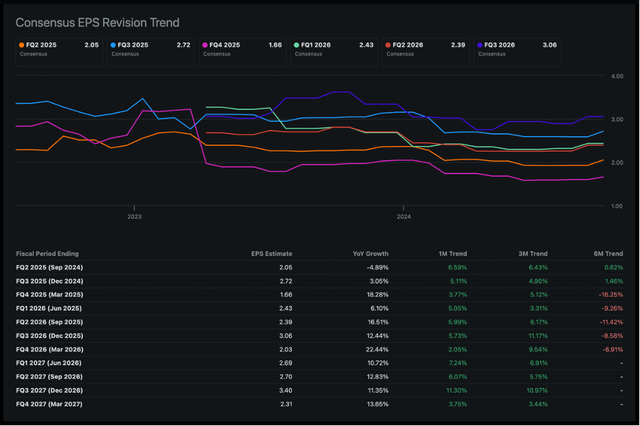
Seeking Alpha
Additionally, Alibaba will most likely profit from the Chinese economy continuing to grow and for the years to come, the IMF is expecting still low-to-mid-single digit growth.
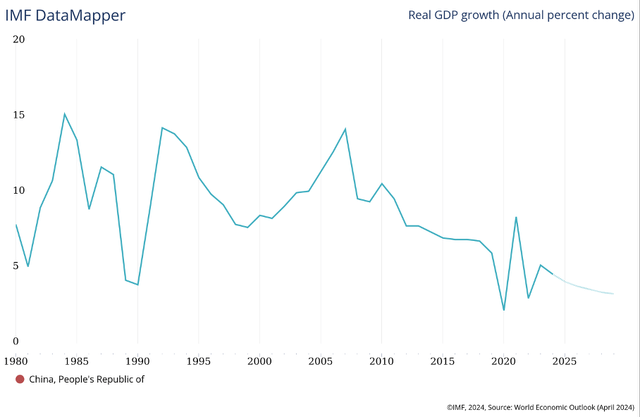
IMF
And growth will especially stem from a growing cloud market as well as a growing e-commerce market. According to different studies, the Chinese E-commerce market is expected to grow with a CAGR of 11.30% in the years to come. Other studies are a little more cautious, but still see growth rates of close to 10% in the years till 2030.
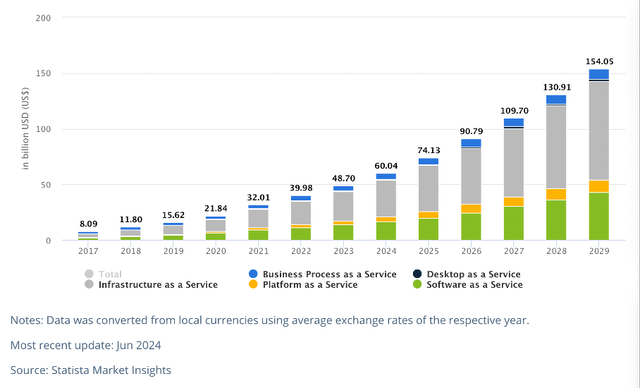
Statista
And while the Chinese E-commerce market is expecting to grow at least in the high single digits, the Chinese cloud market is expected to grow even with a CAGR of 20% in the next few years. All in all, I see several growth opportunities for Alibaba, and I am confident the company can continue to grow its business – probably even at a high pace.
Intrinsic Value Calculation
As pointed out several times in the past, Alibaba is currently trading for extremely low valuation multiples, making the stock appear extremely cheap. When looking at the price-earnings ratio, Alibaba is trading for 18 times earnings right now and although this is clearly below the 10-year average of 35.88, a valuation multiple of 18 is not extremely high but also not extremely cheap.
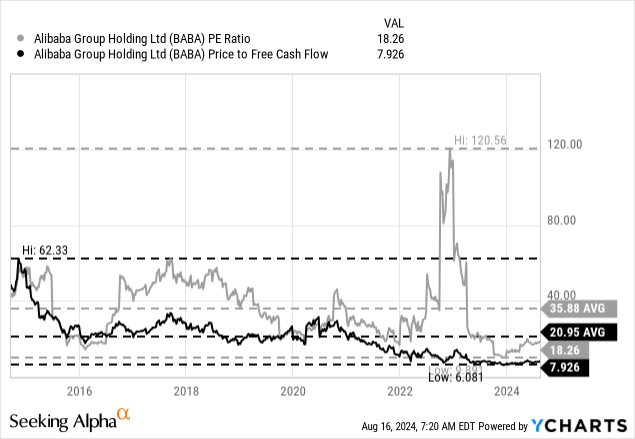 Data by YCharts
Data by YCharts
However, when looking at the price-free-cash-flow ratio, which is the more important metric, the stock is trading only for a multiple of 8. This is not only below the 10-year average of 20.95, but an extremely low valuation multiple by any standard.
Additionally, we are calculating an intrinsic value by using a discount cash flow calculation. As always, we are calculating with a discount rate of 10% as this is the annual return we like to achieve with an investment. We are also calculating with the last reported number of outstanding shares, which was 2,498 million and as basis for our calculation we take the free cash flow of the last four quarters ($25.54 billion).
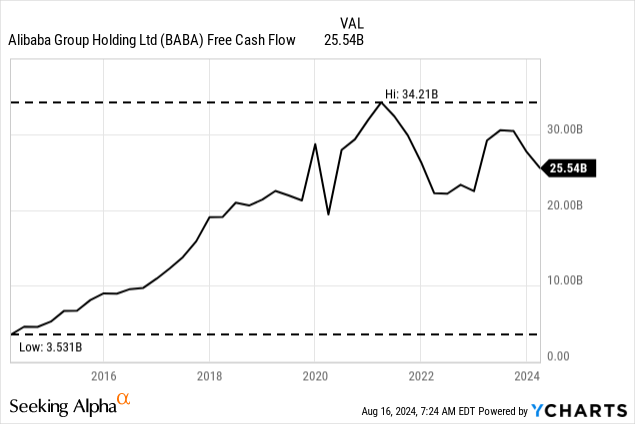 Data by YCharts
Data by YCharts
In the past, I often calculated with 0% growth for the years to come to show that Alibaba is undervalued even when calculating with extremely conservative assumptions. And calculating with 0% growth leads to an intrinsic value of $102.24 making Alibaba still undervalued.
Looking at the last few years makes it seem reasonable to calculate with 0% growth, as Alibaba really has troubles growing right now. But we should not ignore that Alibaba is struggling right now along with the Chinese economy. However, phases of economic downturns will pass, and Alibaba will most likely be able to grow again. When assuming only 3% growth in the years to come, we already get an intrinsic value of $146.06 for Alibaba, making the stock really a bargain.
In my opinion, the Chinese economy will not only be able to grow again, at least in the low-to-mid single digits, but I also assume that Alibaba will be able to outperform the Chinese economy by taking market shares as well as international expansion. While I would already expect Alibaba’s top line to grow at a higher pace than only low single digits, the company can also use share buybacks and improving margins (especially those segments that are still not profitable) for an even higher bottom-line growth. Of course, when calculating with higher growth rates, Alibaba would be even more undervalued, but I think we can leave it at that: In my opinion, Alibaba is a bargain and clearly undervalued!
Conclusion
In my opinion, Alibaba remains one of the best investments in this market. The stock is deeply undervalued and even when assuming that Alibaba will continue to struggle and not be able to grow, the stock is still undervalued at this point.
Editor's Note: This article discusses one or more securities that do not trade on a major U.S. exchange. Please be aware of the risks associated with these stocks.
Disclaimer: Investing carries risk. This is not financial advice. The above content should not be regarded as an offer, recommendation, or solicitation on acquiring or disposing of any financial products, any associated discussions, comments, or posts by author or other users should not be considered as such either. It is solely for general information purpose only, which does not consider your own investment objectives, financial situations or needs. TTM assumes no responsibility or warranty for the accuracy and completeness of the information, investors should do their own research and may seek professional advice before investing.

